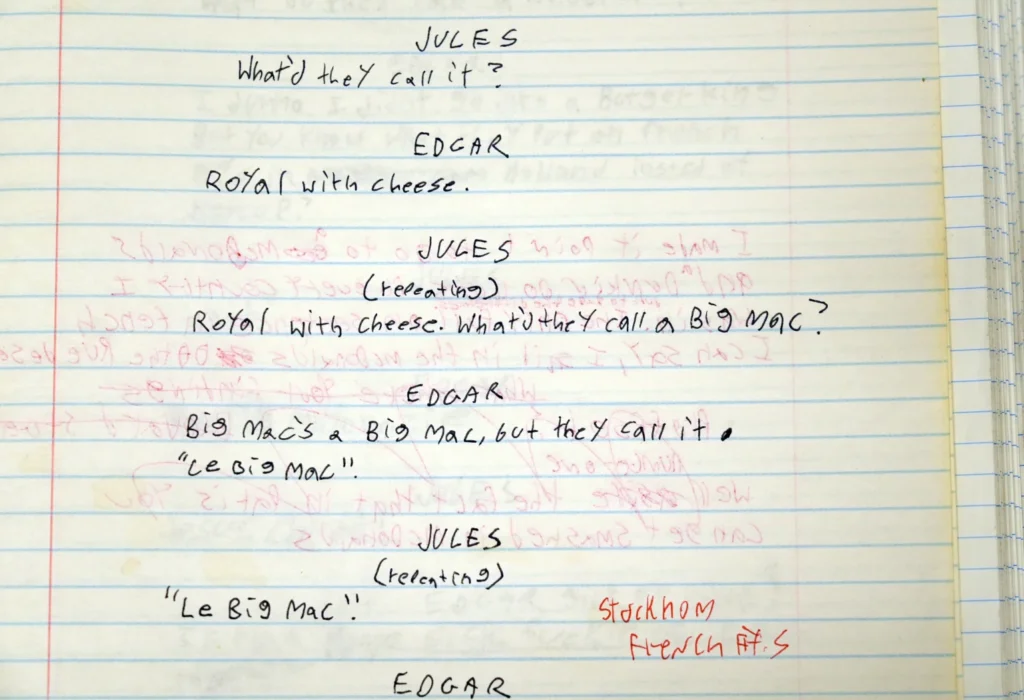Quentin Tarantino’s “Pulp Fiction” is more than a film—it’s a piece of cultural history that revolutionized cinema in the 1990s and established Tarantino as a master storyteller. Known for its dark humor, non-linear structure, and sharp dialogue, “Pulp Fiction” captivated audiences and critics alike. Recently, the film’s legacy took on new dimensions when Tarantino donated a handwritten draft of the script to the Academy’s Pickford Center for Motion Picture Study. This article delves into the critical importance of preserving such artifacts and the role of the Pickford Center in safeguarding cinematic history.
A handwritten draft of “Pulp Fiction” is more than an early version of a script—it’s a window into Tarantino’s evolving ideas, unpolished moments, and the creative energy that fueled one of his most iconic works. The draft reveals Tarantino’s distinctive writing style, including his love for rapid-fire dialogue and character quirks. Rough annotations, lines scratched out, and spontaneous notes capture the raw intensity of his creative process. Here, we see the early traces of iconic scenes like Jules and Vincent’s “Royale with Cheese” conversation, offering insight into the unfiltered mind behind the film.
In preserving these original drafts, we gain a unique understanding of how *Pulp Fiction* evolved from concept to classic, showcasing Tarantino’s willingness to experiment and refine his vision. Each scribble and crossed-out line speaks to his commitment to character-driven storytelling, revealing the meticulous, almost obsessive attention to dialogue that defined the film.
Housed in the heart of Los Angeles, the Pickford Center for Motion Picture Study stands as a landmark dedicated to preserving film heritage. Operated by the Academy of Motion Picture Arts and Sciences, this facility holds an extensive collection of film artifacts, including over 230,000 items in the Academy Film Archive. Named after Mary Pickford, a founding member of United Artists and an icon of early cinema, the center embodies the spirit of film preservation by making rare and valuable pieces of cinema history accessible to researchers and enthusiasts alike.
Built in 1948 as a radio and television studio, the Pickford Center is now the oldest surviving studio building in Los Angeles, a testament to its enduring place in the city’s film history. It houses the Linwood Dunn Theater, a state-of-the-art 286-seat screening room, used for both public programming and Academy member screenings. With a space that encourages public access to film history, the Pickford Center ensures that audiences experience the richness of preserved cinematic works.
The preservation of primary sources—handwritten drafts, original film reels, and archival footage—allows future generations to explore the nuanced history of cinema. Tarantino’s handwritten draft for “Pulp Fiction” offers scholars and fans a chance to see the unfiltered ideas that shaped the film. This kind of preservation allows us to trace the artistic choices and creative shifts, revealing how iconic scenes were crafted and refined.
For Tarantino, whose work often pushes the boundaries of genre and storytelling, preserving such a draft provides invaluable insight into his craft. Examining these original pages, we gain a deeper understanding of how he navigated the blending of genres and infused his characters with authenticity. By viewing the film as a living, evolving work rather than a static product, the draft adds dimension to our appreciation of “Pulp Fictions impression.
In October 2024, Tarantino’s donation of his handwritten “Pulp Fiction” draft further elevated the Pickford Center’s role as a guardian of cinematic heritage. This draft, now part of the Academy’s collection, stands alongside other artifacts that contribute to a broader understanding of film history. The donation underscores Tarantino’s recognition of the importance of preserving film artifacts—not only as historical documents but as sources of inspiration for future filmmakers and scholars.
The Pickford Center’s collection spans more than films alone; it includes scripts, photographs, and other ephemera, each piece serving as a touchstone of a specific era or style. By making these materials accessible, the Pickford Center fosters an environment where scholarship, nostalgia, and creativity intersect. Researchers can delve into the archives, exploring primary materials to gain fresh perspectives and insights.
The legacy of “Pulp Fiction” extends beyond the screen, influencing generations of filmmakers and becoming a cultural reference point. The preservation of Tarantino’s handwritten draft serves as a reminder of the film’s journey from an idea to a groundbreaking work of cinema. It highlights how the Pickford Center, as an institution, plays a vital role in documenting and protecting film history.
In preserving artifacts like Tarantino’s draft, the Pickford Center upholds the integrity of cinema as both an art form and a cultural record. These efforts ensure that film history remains a living dialogue between past and future generations, where works like *Pulp Fiction* continue to inspire, provoke, and entertain.
No comments yet.








